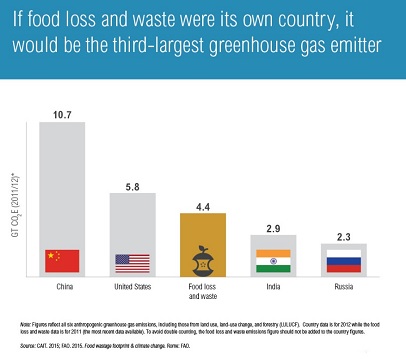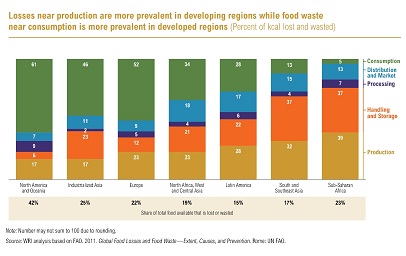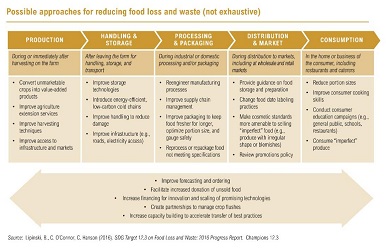|
|
|
You can get e-magazine links on WhatsApp. Click here
|
|
|
|
|
|
Food loss & waste amounts to economic losses worth $940 billion worldwide
|
|
Tuesday, 29 August, 2017, 08 : 00 AM [IST]
|
|
Liz Goodwin
|
Every year, one-third of all food produced for people is never eaten. This level of waste and inefficiency has serious impacts for people, the economy and the planet.
The challenge is human. In a world where one in nine people are undernourished, the fact that more than one billion tonne of food never gets consumed is a travesty. Food insecurity plagues many countries to varying degrees.
The challenge is economic. Food loss and waste amounts to economic losses of $940 billion worldwide per year. In sub-Saharan Africa, for example, post-harvest grain losses total $4 billion per year. In the United States, the average family of four wastes roughly $1,500 worth of food annually. Every level loses out – from the multinational company to the home. There’s a strong business case for reducing food loss and waste that every company should know.
And the challenge is environmental. Food that is harvested but ultimately lost or wasted consumes about one-quarter of all water used by agriculture each year and requires an area nearly three times the size of India to be grown. Food loss and waste is responsible for an estimated eight per cent of annual greenhouse gas emissions; if it were a country, food loss and waste would be the third-largest emitter in the world, after China and the United States and just before India.

Food Losses in the Supply Chain and Food Waste in the Household
There are some unique trends in where and how food is lost or wasted from farm to fork.
In developing countries, losses tend to happen closer to the farm. In South and Southeast Asia, for example, 69 per cent of food that is lost or wasted happens in production or during storage and handling. Poor harvesting equipment, pests and fungi are just a few of the reasons for this.
In developed countries, food is wasted closer to the fork. In industrialised Asia, 57 per cent of food that is wasted happens at the distribution and consumption levels. This can take the form of fruits and vegetables that retailers might choose to throw away rather than place out for sale because they do not meet consumer expectations about appearance, or when restaurants or households ditch what was not eaten at dinner.

Households are especially wasteful, even in urban areas in emerging economies. As families’ income levels rise, the relative cost of food decreases – food begins to take up a smaller portion of the family budget, and with it, less relative importance and value. Because of this fact, addressing household level food waste requires a multi-pronged approach that helps consumers understand the costs and benefits of reducing their own food waste.
But no matter where or how food is lost or wasted, we all have a role to play in cutting such waste and inefficiency from our global and national food supplies.
However, there is still too little being done. Many businesses and governments are unaware of the scale of the issue, the impact on them and what they can do in practice. There are real opportunities for companies and countries tackling food waste – which will benefit their bottom lines and society.
A Three-Step Approach
Tackling food loss and waste requires action across the world and across industries, up and down the supply chain. The scale of the problem is so large that it cannot be adequately addressed by any single actor.
Fortunately, getting started is fairly straightforward. A three-step process can help managers know where to focus their efforts:
1. Target - Targets set ambition, and ambition motivates action. Every company involved in the food supply chain as well as every nation and major city should set food loss and waste reduction targets consistent with Target 12.3 of the Sustainable Development Goals. Target 12.3 specifically calls upon the world to “halve per capita global food waste at the retail and consumer levels and reduce food losses along production and supply chains, including post-harvest losses” by 2030. It’s ambitious, but doable.
2. Measure - Every manager knows that what gets measured gets managed, which is why companies and governments must measure their food loss and waste. Doing so is foundational for understanding how much, where and why it is occurring, and for being able to monitor progress over time. The Food Loss and Waste Accounting and Reporting Standard (www.flwprotocol.org) can help companies begin. The standard is the first-ever set of global definitions and reporting requirements for companies, countries and others to consistently and credibly measure, report on and manage food loss and waste.
3. Act - Impact only occurs if people act. Governments and companies should accelerate and scaleup the adoption of policies, incentives, investments and practices that reduce food loss and waste. Exact approaches will vary for each organisation, but there are options for all.

Leadership in Champions 12.3
Around the globe, there are leaders across industry, government, academia and civil society who are vocal about the urgent need to reduce food loss and waste, and are working to set the world on a path toward achieving Target 12.3 of the Sustainable Development Goals.
Nearly 40 such leaders have formed Champions 12.3 (www.champions123.org), a coalition dedicated to inspiring ambition, mobilising action and accelerating progress toward Target 12.3. These CEOs, government ministers and others are highly influential, including leading vast companies with operations in India.
Together, members of Champions 12.3 assess global progress toward Target 12.3, share successful reduction efforts and how to overcome barriers, amplify issues around food loss and waste in the media, and identify new windows of opportunity.
The coalition will soon release data that shows the kind of positive return on investment that results from curbing such waste. More and more companies are beginning to tackle food loss and waste in their operations, and they are seeing significant results in their bottom lines. The soon-to-be released research also outlines a number of strategic, yet non-financial reasons companies feel it’s important to take action. The Business Case for Reducing Food Loss and Waste will be available on the Champions 12.3 website in early March.
In September, the coalition will release its second annual report, highlighting reduction efforts around the world and identifying where progress must accelerate if we are to halve food waste and reduce food loss by 2030.
Launched early last year, the young coalition is having an impact, and is still growing its membership in countries like India.
We Can Halve Food Loss and Waste
Reducing food loss and waste is a rare example of a win-win. It’s good for companies and people, the planet and building a future that can sustainably feed the world’s growing population.
With enough action, we can halve food loss and waste. Learn more about how to become involved by visiting www.champions123.org and www.flwprotocol.org.
(The author is senior fellow and director, food loss and waste, World Resources Institute. She can be contacted at liz.goodwin@wri.org.)
|
|
|
|
|
|
|
|
|
|